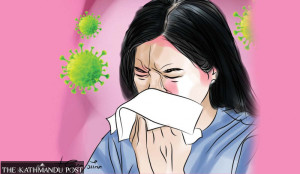Health
More than 900 people in 47 districts test positive for dengue virus
All three districts in the Valley—Kathmandu, Lalitpur and Bhaktapur—have reported the disease.
Arjun Poudel
As the monsoon sets in causing deaths and devastation, many districts across the country have started reporting outbreaks of the dengue virus.
According to the Epidemiology and Disease Control Division, since the beginning of 2023, as many as 946 cases of dengue infection have been found in 47 districts, including in all three districts of the Kathmandu Valley—Kathmandu, Lalitpur and Bhaktapur.
“Most of the cases were reported in recent days,” said Dr Gokarna Dahal, chief of the Vector Control Section at the division. “We suspect a cluster outbreak of the dengue virus in many places.”
Monsoon in Nepal is a season of epidemics when thousands of people across the country get infected with water-borne and vector-borne diseases.
Although the post-monsoon season is considered fertile for dengue transmission, Nepal has witnessed outbreaks of the deadly disease since the start of the year and during the pre-monsoon seasons as well. Experts say the virus has become endemic, as cases of dengue infection are being reported throughout the year.
According to the division, 46 cases of dengue virus have been reported from Kathmandu, 32 from Bhaktapur and 12 cases from Lalitpur district. Dharan Sub-metropolitan City reported 52 cases of dengue infection.
Experts say the reported dengue cases could be just the tip of the iceberg, as around 90 percent of the infected people do not show any symptoms.
Last year, at least 88 people died and over 54,000 were infected by the virus, which had spread to all 77 districts of the country. Hospitals in the Kathmandu Valley were overwhelmed with dengue patients and many complain that they were deprived of treatment. Pharmacies also lacked paracetamol at the time.
The number of deaths from dengue infection in Nepal is considered too high.
Negligence in the case of management of the disease, not taking preventive measures, lack of public awareness of the risks, and delay in seeking health care services after catching the infection could be among the reasons for the high death rate from the virus, according to experts. Dengue virus serotype DENV-1, DENV-2, and DENV-3 were found responsible for the dengue epidemic in the country.
In 2019, six people had died and more than 16,000 were hospitalised from dengue infection, which gripped 68 districts.
Entomologists warn that the dengue spread could surge again, as no serious initiatives have been taken to destroy the eggs of infected mosquitoes.
“We have alerted all agencies of districts about the outbreak of the dengue virus, and have urged them to begin a ‘search and destroy’ drive,” said Dahal. “Testing kits have been supplied and the orientation of health workers has been completed.”
Dengue is a mosquito-borne disease transmitted by female Aedes aegypti and Aedes albopictus mosquitoes. The same vector also transmits chikungunya, yellow fever, and Zika, according to the World Health Organisation.
According to doctors, mild to high fever, severe muscle pain, rashes, severe headache, and pain in the eyes are some of the symptoms of dengue, and the treatment should be sought immediately, if anyone experiences those symptoms. While there is no specific cure for the disease, early detection and access to proper medical care can lower fatalities.
Dengue-transmitting mosquitoes breed in clean water and bite people in daylight. Uncovered water tanks and discarded plastic cups and bottles could become breeding grounds for the dengue-carrying mosquitoes.




 9.12°C Kathmandu
9.12°C Kathmandu












%20(1).jpg&w=300&height=200)

